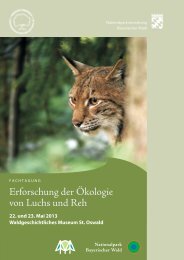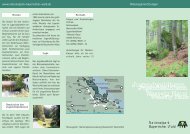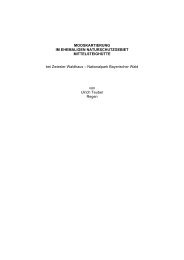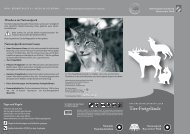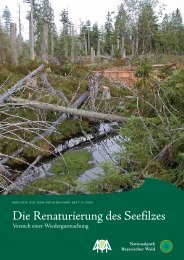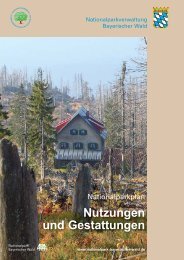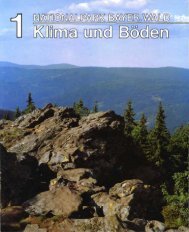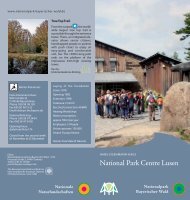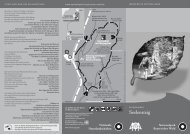The regional economic impact of Bavarian Forest National Park
The regional economic impact of Bavarian Forest National Park
The regional economic impact of Bavarian Forest National Park
Create successful ePaper yourself
Turn your PDF publications into a flip-book with our unique Google optimized e-Paper software.
B E R I C H T E A U S D E M N A T I O N A L P A R K H E F T 4 / 2 0 0 8<br />
<strong>The</strong> <strong>regional</strong> <strong>economic</strong> <strong>impact</strong><br />
<strong>of</strong> <strong>Bavarian</strong> <strong>Forest</strong> <strong>National</strong> <strong>Park</strong>
2 |<br />
© All rights reserved<br />
No reproduction, photo mechanical or electronic duplication <strong>of</strong> this document, including extracts, may be made without the permission <strong>of</strong><br />
the publisher.<br />
PUBLISHED BY: <strong>National</strong>parkverwaltung Bayerischer Wald<br />
Freyunger Straße 2<br />
94481 Grafenau<br />
Telephone: 0049 (0)8552 96 000<br />
Fax: 0049 (0)8552 96 00 100<br />
E-mail: poststelle@npv-bw.bayern.de<br />
www.nationalpark-bayerischer-wald.de<br />
EDITOR-IN-CHIEF: Dr. Heinrich Rall<br />
ACCOUNTABLE: Karl Friedrich Sinner<br />
Director <strong>of</strong> the <strong>Bavarian</strong> <strong>Forest</strong> <strong>National</strong> <strong>Park</strong> Authority<br />
EDITORIAL TEAM: Rainer Pöhlmann, Dr. Heinrich Rall, Josef Wanninger<br />
TRANSLATION: Morwenna <strong>Park</strong>yn<br />
PROOFREADER: Marius Mayer, Dr. Martin Müller, Manuel Woltering<br />
DESIGN: Annemarie Schmeller<br />
TITLE COVER: Group <strong>of</strong> tourists on the peak <strong>of</strong> Mt Lusen (1373 m), June 2007 (Marius Mayer)<br />
July 2008 | English version July 2010
3 |<br />
Content<br />
<strong>The</strong> <strong>regional</strong> <strong>economic</strong> <strong>impact</strong><br />
<strong>of</strong> <strong>Bavarian</strong> <strong>Forest</strong> <strong>National</strong> <strong>Park</strong><br />
Foreword ...................................................................................................................... 4<br />
1. Introduction .................................................................................................................5<br />
2. Methods........................................................................................................................ 5<br />
3. Visitor numbers........................................................................................................... 6<br />
4. Importance <strong>of</strong> the national park brand in the <strong>Bavarian</strong> <strong>Forest</strong> ............................. 8<br />
5. <strong>The</strong> <strong>regional</strong> <strong>economic</strong> <strong>impact</strong> <strong>of</strong> tourism in <strong>Bavarian</strong> <strong>Forest</strong> <strong>National</strong> <strong>Park</strong>...11<br />
5.1 Day-trippers .............................................................................................................................. 11<br />
5.2 Overnight visitors ..................................................................................................................... 12<br />
5.3 Gross tourist spending ............................................................................................................. 12<br />
5.4 Income effects............................................................................................................................ 13<br />
5.5. Employment effects: Income equivalents.............................................................................. 13<br />
6. <strong>The</strong> <strong>economic</strong> significance <strong>of</strong> tourism in the region .............................................14<br />
7. Intermediate input linkages......................................................................................15<br />
8. Perceptions <strong>of</strong> dead wood areas and the bark beetle.............................................16<br />
9. Cost-benefit analysis .................................................................................................17<br />
10. Transboundary destination Šumava <strong>National</strong> <strong>Park</strong><br />
and <strong>Bavarian</strong> <strong>Forest</strong> <strong>National</strong> <strong>Park</strong> ........................................................................18<br />
11. Conclusion..................................................................................................................18<br />
References...................................................................................................................20<br />
Impressum..................................................................................................................21
4 |<br />
Foreword<br />
25 years have passed since the last study on the <strong>regional</strong> <strong>economic</strong> <strong>impact</strong> <strong>of</strong> the <strong>Bavarian</strong> <strong>Forest</strong> <strong>National</strong> <strong>Park</strong>. Much has<br />
changed in and around the park since then. Left to themselves, ecosystem dynamics have given the forest a different appearance,<br />
which, at the same time, has led to lively discussions about the concept <strong>of</strong> ecological integrity in the national park. With the<br />
park’s expansion in 1997 and the creation <strong>of</strong> Šumava <strong>National</strong> <strong>Park</strong> in 1992 the concept <strong>of</strong> national parks in the wild heart <strong>of</strong><br />
Europe has gained new significance. In addition, the park has created many new interpretive services, including the Haus zur<br />
Wildnis (<strong>The</strong> house <strong>of</strong> wilderness), the Wilderness Camp Falkenstein and the wildlife park with its ice age cave as well as a high<br />
quality network <strong>of</strong> hiking and cycling trails.<br />
Furthermore, the national park has become more involved in <strong>regional</strong> development, with activities such as the programme <strong>of</strong><br />
national park partners, the tourism project “Tierisch wild” (terribly wild) and the eventful three-year journey <strong>of</strong> the famous glass<br />
ark.<br />
This new study provides its readers with information about the <strong>regional</strong> <strong>economic</strong> <strong>impact</strong> <strong>of</strong> these changes. It also illustrates existing<br />
shortcomings; opportunities created by the existence <strong>of</strong> the national park, which the region is currently not taking advantage<br />
<strong>of</strong>.<br />
I am convinced that the results <strong>of</strong> this research will awaken people’s interest.<br />
We ask the region’s stakeholders to draw appropriate conclusions from the findings and to use them to act collectively to the<br />
benefit <strong>of</strong> the region.<br />
Grafenau, June 2008<br />
Karl Friedrich Sinner<br />
Director <strong>of</strong> the <strong>Bavarian</strong> <strong>Forest</strong> <strong>National</strong> <strong>Park</strong> Authority
5 |<br />
<strong>The</strong> <strong>regional</strong> <strong>economic</strong> <strong>impact</strong> <strong>of</strong><br />
<strong>Bavarian</strong> <strong>Forest</strong> <strong>National</strong> <strong>Park</strong><br />
Hubert Job, Marius Mayer, Manuel Woltering, Martin Müller, Bernhard Harrer, Daniel Metzler<br />
1. Introduction<br />
<strong>National</strong> parks are primarily an instrument for large-scale<br />
preservation <strong>of</strong> natural areas. Traditionally it was the<br />
uniqueness <strong>of</strong> natural phenomena that determined the designation<br />
<strong>of</strong> national parks. Today, ecological reasons such as<br />
the preservation <strong>of</strong> biodiversity are decisive. <strong>National</strong> parks<br />
are about unimpaired ecosystem dynamics or more simply<br />
“letting nature follow its course”. This is a difficult task in<br />
densely populated Central Europe with its long cultural history<br />
and, consequently, a landscape with strong anthropogenic<br />
influences. <strong>National</strong> parks are <strong>of</strong>ten perceived as limiting<br />
factors within a region due to the restrictions that they<br />
bring with them. <strong>The</strong> spatial-functional limitations and their<br />
associated <strong>economic</strong> limitations <strong>of</strong>ten lead to a lack <strong>of</strong> acceptance<br />
among the adjacent local population and local politicians.<br />
As a natural disturbance <strong>of</strong> forest ecosystems the bark<br />
beetle is seen as an additional negative factor in the <strong>Bavarian</strong><br />
<strong>Forest</strong>. This raises questions concerning the management <strong>of</strong><br />
national parks as well as visitors’ perception <strong>of</strong> the changed<br />
forest landscape. In turn, this complicates the sometimes<br />
very emotional debates in the region concerning the virtues<br />
and vices <strong>of</strong> national parks.<br />
Besides the goal <strong>of</strong> nature conservation, national parks <strong>of</strong>fer<br />
an experience value, such as unspoiled wilderness, which can<br />
be used by the tourism industry. <strong>National</strong> parks and their attractions<br />
represent a scarce good because there are only few<br />
suppliers in the market (14 national parks in Germany).<br />
<strong>The</strong>y cannot be replicated, transferred and imitated due to<br />
their legal status (Hannemann/Job 2003). Thus, national<br />
2. Methods<br />
<strong>The</strong> methods are explained in more detail in the full version<br />
<strong>of</strong> the report 1 . <strong>The</strong>refore, we only provide an overview <strong>of</strong> the<br />
three surveys carried out:<br />
• In order to survey the number and distribution <strong>of</strong> visitors<br />
in <strong>Bavarian</strong> <strong>Forest</strong> <strong>National</strong> <strong>Park</strong> across the whole year<br />
2007 appropriately visitor counts and interviews were<br />
carried out on 22 days (on weekdays and weekends) in<br />
the winter, summer and <strong>of</strong>f-peak season. Short interviews<br />
asking for the interviewees’ place <strong>of</strong> origin and type<br />
1 Job, H. (Ed.) (2008): Die Destination <strong>National</strong>park Bayerischer<br />
Wald als <strong>regional</strong>er Wirtschaftsfaktor (= <strong>National</strong>park Bayerischer<br />
Wald Wissenschaftliche Reihe, Sonderheft). Grafenau.<br />
parks are the highlights <strong>of</strong> nature tourism in many countries.<br />
<strong>National</strong> parks in Germany, however, do not always exploit<br />
their uniqueness sufficiently for tourism purposes.<br />
In the context <strong>of</strong> national park tourism in the structurally<br />
weak periphery <strong>of</strong> Lower Bavaria (Niederbayern) this study<br />
examines the following questions:<br />
• How important is tourism as an <strong>economic</strong> and employment<br />
factor?<br />
• From a cost-benefit perspective, what relation do governmental<br />
inputs into the national park have to these results?<br />
• Has the potential <strong>of</strong> the brand “national park” previously<br />
not been recognised or used enough in tourism marketing?<br />
• What <strong>economic</strong> interrelations exist between individual<br />
businesses in the national park surroundings and how do<br />
they benefit directly or indirectly from the presence <strong>of</strong><br />
the protected area?<br />
• How do visitors and tourism entrepreneurs perceive the<br />
dead wood areas and the bark beetle in the national park?<br />
• Are the visitors <strong>of</strong> the neighbouring Šumava <strong>National</strong><br />
<strong>Park</strong> (Czech Republic) a potential target group for the<br />
<strong>Bavarian</strong> <strong>Forest</strong> <strong>National</strong> <strong>Park</strong> and could a stronger cooperation<br />
between the two parks in the field <strong>of</strong> tourism<br />
reach this target group?<br />
<strong>of</strong> accommodation were conducted with 11,140 persons.<br />
1,990 persons were interviewed in more detail about<br />
their spending behaviour and their travel motivation.<br />
• Enterprises in the counties <strong>of</strong> Freyung-Grafenau and Regen<br />
were asked to fill in a written questionnaire. Samples<br />
were taken using a stratified random selection process to<br />
ensure representativeness. With the sample quota<br />
adapted for each industry, 1,832 questionnaires were<br />
mailed out between July and October 2007. 197 were returned,<br />
equalling a return rate <strong>of</strong> 10.8%.
• <strong>The</strong> interviews in which tourists were asked about their<br />
perception <strong>of</strong> the dead wood areas in the national park<br />
were structured to allow as much comparison as possible<br />
with existing studies (Suda/Pauli 1998; Suda/Feicht<br />
Map 1: Survey area <strong>Bavarian</strong> <strong>Forest</strong> and tourism intensity <strong>of</strong> its communities<br />
3. Visitor numbers<br />
<strong>The</strong> survey area includes the counties <strong>of</strong> Freyung-Grafenau<br />
and Regen. Map 1 illustrates the area and its tourism intensity<br />
on a community level. Figure 1 shows the development<br />
<strong>of</strong> overnight stays in the region since the 1980s, compared to<br />
its development in the whole <strong>of</strong> Bavaria and to the booming<br />
branch <strong>of</strong> city tourism.<br />
With a total <strong>of</strong> 760,000 visitors in 2007, the national park is<br />
the most visited attraction in the region and receives almost<br />
three times as many visitors as the Mt Arber ski resort (Harrer<br />
2004). A previous study (Kleinhenz 1982: 52ff.) estimates<br />
that in 1981 between 1.3 and 1.4 million people visited<br />
the national park.<br />
In this study at the beginning <strong>of</strong> the 1980s, however, no systematic<br />
year-round and area-wide visitor counts were carried<br />
out; the quoted figures were based on the estimations <strong>of</strong> the<br />
national park administration. It is therefore impossible to<br />
compare the present study with its predecessor. Thus it<br />
would be wrong to conclude that the interest <strong>of</strong> tourists in<br />
2002). <strong>The</strong> survey took place on weekends and weekdays<br />
in the summer <strong>of</strong> 2007 using a standardised questionnaire.<br />
<strong>The</strong> sample comprises a total <strong>of</strong> 608 respondents.<br />
<strong>Bavarian</strong> <strong>Forest</strong> <strong>National</strong> <strong>Park</strong> has declined over the years.<br />
Visitor counts from the visitor centres Hans-Eisenmann-<br />
Haus and Haus zur Wildnis (opened recently in 2006), provide<br />
a more reliable comparison: In 1982 211,000 people visited<br />
the Hans-Eisenmann-Haus and in 2007 around<br />
255,000 visitors came to both visitor centres.<br />
According to our survey from 2007 visitors are mainly concentrated<br />
around the primary tourist attractions (visitor centres<br />
and their wildlife parks) whereas the rest <strong>of</strong> the visitors<br />
is distributed widely across the whole protected area. Given<br />
this concentration on the visitor centres and the visitor<br />
numbers <strong>of</strong> the latter reported above, a visitor number <strong>of</strong><br />
more than one million, either now or then, does not seem<br />
very realistic.<br />
6
Figure 1: Development <strong>of</strong> overnight stays in the survey area and comparison<br />
areas<br />
Source: Own illustration adapted from LfStaD 2008<br />
Figure 2: Affinity to the label “national park” 2<br />
Source: Own research 2007<br />
67% <strong>of</strong> visitors stay overnight (around 511,000 visitors).<br />
<strong>The</strong> remaining 33% (around 249,000 visitors) are daytrippers.<br />
<strong>The</strong> seasonal changes <strong>of</strong> these visitor numbers confirm<br />
the seasonal visitation pattern in the region: the majority<br />
<strong>of</strong> visitors arrive in the summer and winter season and arrivals<br />
are lower in the <strong>of</strong>f peak months. <strong>The</strong>re are, however, a<br />
few exceptions to the rule, for example during the Easter<br />
holidays and the autumn holidays. <strong>The</strong> highest visitor numbers<br />
in the summer season are registered during July.<br />
<strong>The</strong> majority <strong>of</strong> visitors come from Germany. Only 3.9%<br />
come from foreign countries (see map 2) and then mainly<br />
from neighbouring countries such as the Czech Republic,<br />
Austria or the Netherlands. <strong>The</strong> main place <strong>of</strong> residence for<br />
around 28% <strong>of</strong> the respondents is in the postal code area 94,<br />
i.e. from the area surrounding the national park, reflecting a<br />
vast majority <strong>of</strong> the day-trippers.<br />
2 <strong>The</strong> proportion <strong>of</strong> tourists with a high national park affinity refers to the total number <strong>of</strong> visitors. Visitors who do not know the conservation status<br />
<strong>of</strong> the region (13.9%) or the national park (2.6%) are not included in this percentage.<br />
7
4. Importance <strong>of</strong> the national park brand in the <strong>Bavarian</strong> <strong>Forest</strong><br />
<strong>The</strong> visitors <strong>of</strong> the national park are divided into two groups<br />
according to their affinity to the national park: visitors with<br />
high affinity to the national park (45.8 %, see figure 2) and<br />
other visitors (54.2 %).<br />
According to the total number <strong>of</strong> visitors in 2007, the following<br />
division between visitors with high national park affinity<br />
and other visitors as well as the respective percentage<br />
<strong>of</strong> day-trippers and overnight visitors (see figure 3) can be<br />
derived from the visitor structure <strong>of</strong> the national park: Al-<br />
Fig. 3: Visitor structure in <strong>Bavarian</strong> <strong>Forest</strong> <strong>National</strong> <strong>Park</strong><br />
Source: Own research 2007<br />
Only 57.3% <strong>of</strong> the respondents in Berchtesgaden <strong>National</strong><br />
<strong>Park</strong> were able to answer the question about the legal conservation<br />
status <strong>of</strong> the area correctly. In Müritz the number<br />
was 76.7%, even topped by <strong>Bavarian</strong> <strong>Forest</strong> with 86.1 %.<br />
<strong>The</strong> role <strong>of</strong> the conservation status <strong>of</strong> the area in visitors’ decision<br />
to visit the region varies significantly. <strong>The</strong> majority <strong>of</strong><br />
respondents (54.7 %) placed themselves under the two top<br />
categories “the national park was a very important reason for<br />
this visit“ and “...was a major reason for the visit“. It is interesting<br />
to note here that the national park has a higher significance<br />
for overnight visitors than for day-trippers. Nevertheless,<br />
it should be remarked that the share <strong>of</strong> visitors with<br />
a high national park affinity is not completely satisfactory.<br />
<strong>The</strong> share <strong>of</strong> visitors with a high national park affinity visiting<br />
Müritz <strong>National</strong> <strong>Park</strong>, which is 20 years younger, already<br />
lies just below that <strong>of</strong> the <strong>Bavarian</strong> <strong>Forest</strong>. Reasons for<br />
this are, first, the much longer existence <strong>of</strong> market-based<br />
tourism in the <strong>Bavarian</strong> <strong>Forest</strong>. Thus, even without the national<br />
park, the region is part <strong>of</strong> tourists’ mental map when it<br />
comes to their travel decision because <strong>of</strong> other attractions.<br />
most half <strong>of</strong> the tourists are motivated to visit the region because<br />
<strong>of</strong> the presence <strong>of</strong> the national park. This shows the<br />
leading position <strong>of</strong> <strong>Bavarian</strong> <strong>Forest</strong> <strong>National</strong> <strong>Park</strong> as a German<br />
national park destination. This result is a positive outcome<br />
for <strong>Bavarian</strong> <strong>Forest</strong> <strong>National</strong> <strong>Park</strong> when compared to<br />
others: <strong>The</strong> park lies ahead <strong>of</strong> both Müritz <strong>National</strong> <strong>Park</strong><br />
(43.7%) and Berchtesgaden <strong>National</strong> <strong>Park</strong> (10.1%)<br />
(Job/Metzler/Vogt 2003: 129; Job et al. 2005: 62).<br />
Second, the interviews with the tourism entrepreneurs<br />
(owners <strong>of</strong> tourism businesses) show that the identification<br />
<strong>of</strong> the local population with <strong>Bavarian</strong> <strong>Forest</strong> <strong>National</strong> <strong>Park</strong><br />
is weaker than it is in the Müritz region.<br />
Fig. 4: <strong>The</strong> role <strong>of</strong> the national park in the decision to visit the area<br />
Source: Job/Metzler/Vogt 2003, Job et al. 2005, own research 2007<br />
8
<strong>The</strong> national park only plays a relatively small role in the<br />
marketing mix <strong>of</strong> the responding enterprises, despite the fact<br />
that the national park has existed in the region for almost<br />
four decades now and despite the high interest <strong>of</strong> tourists in<br />
the protected area (see figure 4).<br />
<strong>The</strong> national park has a similar importance as in Berchtesgaden<br />
and a much lower importance than in Müritz <strong>National</strong><br />
<strong>Park</strong> (see figure 5).<br />
Fig. 5: Distribution <strong>of</strong> answers to the question ”<strong>The</strong> <strong>National</strong> <strong>Park</strong> plays an important role in my marketing”<br />
Source: Job et al. 2004a,b and own research 2007<br />
<strong>The</strong>re is still a lot to be done where internal marketing in<br />
the region is concerned, because accommodation providers<br />
(particularly in the extension area) do not promote the national<br />
park enough to their guests. Even though recently,<br />
for example, the East <strong>Bavarian</strong> Tourism Association has<br />
started promoting the national park more strongly, many<br />
<strong>of</strong> the local enterprises do still not recognize this marketing<br />
opportunity because they lack own initiatives. However,<br />
also in marketing outside <strong>of</strong> the region there is a lack <strong>of</strong><br />
tourism products which are specific to the national park<br />
and take the market demands into consideration. In addi-<br />
<strong>The</strong>re are, however, significant <strong>regional</strong> differences between<br />
the original part <strong>of</strong> the national park in the county Freyung-<br />
Grafenau and its extension area in the county <strong>of</strong> Regen (see<br />
figures 5 and 6). In the original part <strong>of</strong> the park a higher percentage<br />
(95%) <strong>of</strong> respondents believed the park to play an<br />
important role in the marketing than those interviewed in<br />
Müritz <strong>National</strong> <strong>Park</strong> (85%). In the extension area, however,<br />
the <strong>Bavarian</strong> <strong>Forest</strong> <strong>National</strong> <strong>Park</strong> plays a less important<br />
role (42%) compared to the alpine Berchtesgaden <strong>National</strong><br />
<strong>Park</strong> (76%).<br />
tion, tourism management, a department that has not been<br />
present before, should become more important within the national<br />
park administration.<br />
In general, the large gap between guests that are aware <strong>of</strong> the<br />
protected area status (86.1% <strong>of</strong> the visitors recognize the national<br />
park) and those for whom the status is the dominant<br />
reason for visiting the area (45.8 %) illustrates a rather large<br />
communication problem <strong>of</strong> the tourism marketing. This is a<br />
critique which is directed primarily at <strong>regional</strong> accommodation<br />
and gastronomy enterprises and not for the national park<br />
administration or the East <strong>Bavarian</strong> Tourism Association.<br />
9
Map 2: Origin <strong>of</strong> visitors to the <strong>Bavarian</strong> <strong>Forest</strong> <strong>National</strong> <strong>Park</strong><br />
10
Fig. 6: Statement pr<strong>of</strong>iles <strong>of</strong> owners <strong>of</strong> tourism businesses<br />
Source: Own research 2007<br />
5. <strong>The</strong> <strong>regional</strong> <strong>economic</strong> <strong>impact</strong> <strong>of</strong> tourism in the <strong>Bavarian</strong> <strong>Forest</strong> <strong>National</strong><br />
<strong>Park</strong><br />
Tourists in the <strong>Bavarian</strong> <strong>Forest</strong> <strong>National</strong> <strong>Park</strong> spend a daily<br />
average <strong>of</strong> EUR 38.70 per person. It is necessary, however,<br />
to distinguish between day-trippers and overnight visitors.<br />
5.1 Day-trippers<br />
– <strong>The</strong> mean daily expenditure <strong>of</strong> visitors with high national<br />
park affinity is around EUR 11.40 per person.<br />
64% <strong>of</strong> this sum is spent on catering, 25% on retail and<br />
11% on other services.<br />
– <strong>The</strong> mean daily expenditure per person <strong>of</strong> other visitors<br />
is EUR 9.30, <strong>of</strong> which 69% is spent on catering, 19% on<br />
retail and 12% on other services.<br />
<strong>The</strong> following expenditure structure (see figure 7) is created<br />
from the total number <strong>of</strong> day-trippers in the national park:<br />
Fig. 7: Distribution <strong>of</strong> the expenditures <strong>of</strong> day-trippers<br />
Source: Own research 2007<br />
11
<strong>The</strong> sum that day-trippers spend in the <strong>Bavarian</strong> <strong>Forest</strong> <strong>National</strong><br />
<strong>Park</strong> is a lot lower than the daily German average <strong>of</strong><br />
EUR 28 per person. <strong>The</strong>re are a number <strong>of</strong> reasons for this<br />
difference:<br />
Day-trippers who were interviewed in the national park do<br />
not just encompass classic day visitors but also a fairly large<br />
percentage <strong>of</strong> local inhabitants who spend their leisure time<br />
in the surrounding area. Naturally, the expenditure by these<br />
locals is low, because they only consume little or even nothing<br />
during their activities in the park. This fact is clearly<br />
highlighted by the high proportion <strong>of</strong> day-trippers in the national<br />
park who do not spend anything (around one-third).<br />
It is also worth noting that the amount day-trippers spend<br />
usually depends on their leisure activity. Hiking is one <strong>of</strong> the<br />
most popular activities in national parks, but traditionally an<br />
activity where people tend to spend less money. Different<br />
possibilities to consume also occur depending on how natural<br />
an area is: the more natural the area the less money is<br />
spent there, which is the case in most national parks. This<br />
explains the difference in expenditure behaviour compared<br />
to more urban regions, which strongly influence the German<br />
average. This information explains the comparatively low<br />
expenditure <strong>of</strong> day-trippers in the <strong>Bavarian</strong> <strong>Forest</strong> <strong>National</strong><br />
<strong>Park</strong>. <strong>The</strong>y visit the park in particular for the nature experience<br />
and not to consume.<br />
5.2 Overnight visitors<br />
Overnight visitors <strong>of</strong> the national park spend a daily average<br />
<strong>of</strong> EUR 49.60 per person, a sum which is also a lot lower<br />
than the German average (EUR 93.30). <strong>The</strong> level <strong>of</strong> expenditure<br />
is strongly influenced by the choice <strong>of</strong> accommodation<br />
and, thus, the accommodation structure <strong>of</strong> the survey area.<br />
Again, there are several reasons that explain the lower average<br />
expenditure:<br />
– <strong>The</strong> national park is situated in a structurally weak, rural<br />
region where cheaper accommodation dominates in<br />
comparison to cities. High-price hotels are rare.<br />
– <strong>National</strong> park visitors tend to prefer private accommodation<br />
or holiday flats (with less than 9 beds) over hotels.<br />
<strong>The</strong> national daily expenditure level in these noncommercial<br />
“private accommodations with less than 9<br />
beds” also lies clearly below the national daily expenditure<br />
levels in commercial accommodation and only adds<br />
up to EUR 48.30.<br />
A differentiation <strong>of</strong> overnight visitors in visitors with a high<br />
national park affinity and other visitors does not reveal differences<br />
in the <strong>Bavarian</strong> <strong>Forest</strong>. Both groups spend EUR<br />
49.60 per person and per day. However, smaller variations can<br />
be noticed in the different <strong>economic</strong> sectors that benefit from<br />
the guests:<br />
– With the visitors with a high national park affinity, 71%<br />
<strong>of</strong> the expenditure goes to the accommodation and catering<br />
industry, 22% to the retail industry and 7% to other<br />
services.<br />
– <strong>The</strong> other visitors spend slightly more on the accommodation<br />
and catering industry (75%) and slightly less on<br />
the retail industry (18%). As above, 7% is spent on other<br />
services.<br />
<strong>The</strong> following figure illustrates the expenditure structure <strong>of</strong><br />
the total number <strong>of</strong> overnight visitors in the <strong>Bavarian</strong> <strong>Forest</strong><br />
<strong>National</strong> <strong>Park</strong> (see figure 8):<br />
Figure 8: Distribution <strong>of</strong> the expenditure <strong>of</strong> overnight visitors<br />
Source: Own research 2007<br />
12<br />
Compared to the Berchtesgaden and Müritz <strong>National</strong> <strong>Park</strong>s<br />
the average daily expenditure <strong>of</strong> the visitors in the <strong>Bavarian</strong><br />
<strong>Forest</strong> <strong>National</strong> <strong>Park</strong> lies in the middle <strong>of</strong> both (see table 2).<br />
5.3 Gross tourist spending<br />
<strong>The</strong> gross tourist spending is calculated by multiplying the<br />
daily expenditure with the number <strong>of</strong> days the visitors spend<br />
in the park. Each year park visitors realise a gross tourist<br />
spending <strong>of</strong> EUR 27.8 million. EUR 13.5 million <strong>of</strong> this,<br />
almost 49%, can be traced back to visitors with a high national<br />
park affinity and EUR 14.3 million to other visitors. A<br />
differentiation between these two target groups shows the<br />
pattern in table 1.<br />
<strong>The</strong> net tourist spending is calculated by subtracting the<br />
VAT from the gross tourist spending. <strong>The</strong> total VAT <strong>of</strong> all<br />
visitors in the <strong>Bavarian</strong> <strong>Forest</strong> <strong>National</strong> <strong>Park</strong> is<br />
EUR 3.8 million. If this amount is subtracted from the gross<br />
tourist spending (EUR 27.8 million) a net tourist spending<br />
<strong>of</strong> EUR 24 million remains.
Table 1: Gross tourist spending <strong>of</strong> visitors in the <strong>Bavarian</strong> <strong>Forest</strong> <strong>National</strong> <strong>Park</strong><br />
Number <strong>of</strong> visitors Daily expenditure in EUR<br />
Gross tourist spending<br />
in million EUR<br />
Visitors with a high national park affinity<br />
350,000 13.5<br />
Day-trippers 100,000 x 11.40 1.1<br />
Overnight visitors 250,000 x 49.60 12.4<br />
Other visitors 410,000 14.3<br />
Day-trippers 151,000 x 9.30 1.4<br />
Overnight visitors<br />
Source: Own research 2007<br />
259,000 x 49.60 12.9<br />
5.4 Income effects<br />
Direct income<br />
<strong>The</strong> complete gross tourist spending created from the direct<br />
expenditure <strong>of</strong> the tourists leads to the direct income. Here<br />
income or added value refers to salaries, wages and pr<strong>of</strong>it.<br />
<strong>The</strong> capture rate, i.e. the percentage <strong>of</strong> initial expenditure retained<br />
in the region, is<br />
– around 37.2 % for day-trippers and<br />
– around 37.5 % for overnight visitors.<br />
<strong>The</strong>se average values are in accordance with the specific conditions<br />
in the <strong>Bavarian</strong> <strong>Forest</strong> as they were calculated using<br />
the expenditure structure <strong>of</strong> the visitors. <strong>The</strong> capture rate,<br />
which is weighted according to the guest structure, is 37.5%<br />
for all visitors.<br />
When compared to the figures from the current study on<br />
expenditure structures in Germany, the capture rate <strong>of</strong> the<br />
overnight visitors in the national park is below the national<br />
average. Nationwide the capture rate <strong>of</strong> overnight visitors in<br />
commercial businesses, private accommodation (under 9<br />
beds) and camping is around 41.3 %.<br />
Indirect income<br />
<strong>The</strong> exact capture rates for the businesses that pr<strong>of</strong>it from<br />
the indirect income can only be derived <strong>regional</strong>ly with the<br />
help <strong>of</strong> detailed analyses. This kind <strong>of</strong> research is very expensive<br />
and time consuming and consequently was not carried<br />
out within the framework <strong>of</strong> this study. For this reason an<br />
empirically established figure from the dwif3 , which is an average<br />
<strong>of</strong> 30% was used here.<br />
Total income<br />
A total income <strong>of</strong> almost EUR 13.5 million (direct and indirect<br />
income) is derived from the gross tourist spending from<br />
day-trippers and overnight visitors in the <strong>Bavarian</strong> <strong>Forest</strong><br />
<strong>National</strong> <strong>Park</strong> (EUR 27.8 million). Around two-thirds <strong>of</strong><br />
this can be allocated to the direct income and one-third to<br />
the indirect income. <strong>The</strong> following figure (fig. 9) shows the<br />
way in which total income is created from the gross tourist<br />
spending in detail:<br />
3 Deutsches Wirtschaftswissenschaftliches Institut für Fremdenverkehr<br />
an der Universität München.<br />
Fig. 9: Calculation <strong>of</strong> the income effects in the <strong>Bavarian</strong> <strong>Forest</strong> <strong>National</strong><br />
<strong>Park</strong><br />
Source: Own research 2007<br />
13<br />
5.5 Employment effects: Income equivalents<br />
A number <strong>of</strong> parameters is needed to calculate the income<br />
equivalent, i.e. the number <strong>of</strong> full-time job equivalents deriving<br />
from the total income captured. <strong>The</strong> average aggregate<br />
income per person can be derived from the number <strong>of</strong> inhabitants<br />
in the gateway-communities and their aggregate<br />
income and lies at EUR 14,387. To calculate the income<br />
equivalent the added value generated by the national park<br />
visitors is divided by the average aggregate income per person.<br />
Differentiating between visitors with a high national<br />
park affinity and other visitors the following results occur:<br />
Visitors with a high national park affinity:<br />
EUR 6.56 million : EUR 14,387 = 456 persons<br />
Other visitors:<br />
EUR 6.95 million : EUR 14,387 = 483 persons<br />
This shows that national park visitors generate an income<br />
equivalent <strong>of</strong> 939 persons whose income relies totally on<br />
tourism in the <strong>National</strong> <strong>Park</strong>.<br />
This figure is, however, merely a book value and in reality<br />
probably more people live at least partly from tourism. This<br />
can be attributed to the fact that those employed in tourism<br />
sometimes<br />
– live only partially from tourism (e.g. renting holiday flats<br />
as a sideline) and
– are not employed on a full-time basis (e.g. part-time position,<br />
seasonal employment, temporary work)<br />
It should be made clear that tourism as a mode <strong>of</strong> employment<br />
definitely has a higher significance than it can be derived<br />
from the mathematically calculated figures above.<br />
Thus, tourism revenues generated by the <strong>Bavarian</strong> <strong>Forest</strong><br />
<strong>National</strong> <strong>Park</strong> have a significant <strong>regional</strong> <strong>economic</strong> <strong>impact</strong> in<br />
this peripheral, rather structurally weak <strong>Bavarian</strong> region. If<br />
Table 2: Summary <strong>of</strong> the <strong>economic</strong> <strong>impact</strong> <strong>of</strong> visitors with a high national park affinity<br />
Berchtesgaden<br />
<strong>National</strong> <strong>Park</strong><br />
14<br />
the income <strong>of</strong> all national park visitors is taken as being<br />
EUR 13.5 million, it is (in absolute terms) almost twice as<br />
much as the income generated for the region from the ski resort<br />
at Mt Arber (see dwif 2003). This shows that both nature-based<br />
national park tourism and infrastructure-based<br />
forms <strong>of</strong> tourism are very important for the tourism products<br />
in the area and are not mutually exclusive within one<br />
destination.<br />
<strong>Bavarian</strong> <strong>Forest</strong><br />
<strong>National</strong> <strong>Park</strong><br />
Müritz <strong>National</strong> <strong>Park</strong><br />
Number <strong>of</strong> visitors 114,000 (1,129,000*) 350,000 (760,000*) 167,000 (390,000*)<br />
Ø daily expenditure per person EUR 44.27 EUR 38.70 EUR 33.80<br />
Gross tourist spending<br />
EUR 9.3 million**<br />
EUR 13.5 million EUR 5.6 million<br />
Direct income<br />
EUR 3.1 million<br />
EUR 4.3 million EUR 1.9 million<br />
Indirect income<br />
EUR 1.5 million<br />
EUR 2.2 million EUR 0.9 million<br />
Total income<br />
EUR 4.6 million<br />
EUR 6.5 million EUR 2.8 million<br />
Income equivalent 206 persons 456 persons 261 persons<br />
*all national park visitors<br />
**Different basis <strong>of</strong> calculation due to different survey methods<br />
Source: Job/Metzler/Vogt 2003; Job et al. 2005; own research 2007<br />
6. <strong>The</strong> <strong>economic</strong> significance <strong>of</strong> tourism in the region<br />
<strong>The</strong> results <strong>of</strong> the study on the <strong>regional</strong> <strong>economic</strong> <strong>impact</strong> <strong>of</strong><br />
the national park tourism need to be interpreted correctly by<br />
looking at their relation to the total <strong>economic</strong> <strong>impact</strong> <strong>of</strong><br />
tourism in the survey area derived from the survey <strong>of</strong> the<br />
tourism and non-tourism enterprises. This <strong>economic</strong> <strong>impact</strong><br />
is 11.1% for the counties Freyung-Grafenau and Regen and<br />
13.2% for the more tourism orientated gateway communities.<br />
This share encompasses the added value for the accommodation<br />
and catering industry, the respective shares <strong>of</strong><br />
businesses from the cultural, sport and leisure, manufacturing,<br />
trade sectors and other services that directly or indirectly<br />
generate turnover from tourists or tourism enterprises. <strong>The</strong><br />
indirect effects <strong>of</strong> investments induced by tourism in the region<br />
are also taken into consideration.<br />
If the added value generated by tourism in the national park<br />
is compared to the total added value <strong>of</strong> tourism in the region,<br />
it becomes clear that around 10% <strong>of</strong> the added value at gateway<br />
community level is generated by visitors with a high national<br />
park affinity and one-fifth by all national park visitors.<br />
As expected, the significance <strong>of</strong> national park tourism decreases<br />
if the added value is observed separately at the county<br />
level: Between 2 and 4.5% <strong>of</strong> the added value <strong>of</strong> tourism for<br />
the whole region can be traced back to the national park.<br />
Figure 10: Tourism income multipliers in the counties <strong>of</strong> Freyung-<br />
Grafenau and Regen<br />
Source: Own research 2007
It is not just the tourism industry that benefits from tourism<br />
in the region: indirect (tourism enterprises sourcing intermediate<br />
inputs in the region, investments in the region) and<br />
induced effects (salaries and wages from tourism employees)<br />
increase the tourism added value <strong>of</strong> the region by factors between<br />
1.38 (indirect effects only), 1.53 (taking tourism induced<br />
investments into account) and 1.79 (including the effects<br />
induced through salaries and wages) (see fig. 10).<br />
This means that every Euro spent in the region leads to a<br />
maximum added value <strong>of</strong> EUR 1.79 in the region. Thus, intermediate<br />
input linkages create an indirect and induced additional<br />
income <strong>of</strong> a minimum <strong>of</strong> 38 and a maximum <strong>of</strong> 79<br />
cents for each Euro spent on tourism services. <strong>The</strong>se multipliers<br />
decrease slightly within the gateway communities due<br />
to the less diversified economy in these smaller areas.<br />
7. Intermediate input linkages<br />
<strong>The</strong> large multiplier effect <strong>of</strong> the tourism added value occurs<br />
because the majority <strong>of</strong> the money spent by tourists in the<br />
region stays there and this in turn generates further added<br />
value and employment opportunities. This is illustrated by<br />
the spatial distribution <strong>of</strong> intermediate input linkages <strong>of</strong> the<br />
industries that were analysed in the <strong>Bavarian</strong> <strong>Forest</strong> and<br />
highlights the strong <strong>regional</strong> basis <strong>of</strong> the tourism industry:<br />
only between 28 and 34% <strong>of</strong> the intermediate inputs come<br />
Table 3: Spatial distribution <strong>of</strong> the intermediate input linkages<br />
Industry<br />
Intermediate<br />
inputs from<br />
Manufacturing enterprises,<br />
trades,<br />
other services<br />
Community<br />
(business location)<br />
15<br />
If the number <strong>of</strong> people employed in tourism is compared<br />
with the 456 persons that are estimated to be working in<br />
tourism jobs directly connected to the national park the following<br />
results can be seen: 3.5% <strong>of</strong> the tourism employees in<br />
the counties <strong>of</strong> Regen and Freyung-Grafenau are dependent<br />
on the tourism created by the <strong>National</strong> <strong>Park</strong>. When observed<br />
at gateway community level this figure rises to 13.5%.<br />
If it is only the number <strong>of</strong> people working directly in accommodation<br />
and catering that is taken into consideration<br />
the figure increases again to 14.2%. This proves that national<br />
park tourism is an important employment factor for the region.<br />
It is also worth noting that additionally more than 200<br />
persons are employed by the national park administration.<br />
from outside the region. Approximately 40% <strong>of</strong> the intermediate<br />
inputs required by accommodation businesses are<br />
sourced from within the community where the business is<br />
situated. 93% <strong>of</strong> the investments on renovations or reconstructions<br />
and 76% <strong>of</strong> the investments on equipment for<br />
tourism enterprises are spent in the region. This shows that<br />
the tourism industry is also a driving force for local craftsmen<br />
and suppliers (see table 3).<br />
Counties <strong>of</strong> REG and FRG<br />
Outside the counties <strong>of</strong><br />
REG and FRG<br />
15.0 % 15.7 % 71.3 %<br />
Culture, sport, leisure 40.7 % 19.7 % 48.7 %<br />
Tourism enterprises<br />
(accommodation)<br />
Tourism enterprises<br />
(catering)<br />
Source: Own research 2007<br />
39.5 % 32.3 % 28.3 %<br />
32.9 % 33.5 % 33.6 %
8. Perceptions <strong>of</strong> dead wood areas and the bark beetle<br />
Just over a third <strong>of</strong> all tourism entrepreneurs in our survey<br />
believe that the national park should maintain a “healthy”,<br />
“green” forest and that its role as a nature conservation institution<br />
should consist in controlling the bark beetle. Among<br />
others, they argue that the tourism in the region would suffer<br />
from the unaesthetic and unattractive dead wood areas <strong>of</strong><br />
the park. <strong>The</strong>re is, however, a clear discrepancy between how<br />
entrepreneurs and tourists perceive the problem in the national<br />
park.<br />
Figure 11: Comparison <strong>of</strong> the attitude <strong>of</strong> visitors and tourism businesses towards the bark beetle infestations<br />
Source: Own research 2007<br />
Significant differences can be seen between the gateway<br />
communities in the original area <strong>of</strong> the national park<br />
(County Freyung-Grafenau) and those in the extension area<br />
(County Regen) (see figure 11): nearly 50% <strong>of</strong> the respondents<br />
in the extension area agree with the hypothesis that<br />
“the bark beetle infestations in the <strong>National</strong> <strong>Park</strong> have a<br />
negative <strong>impact</strong> on tourism”, whereas only 25.9 % <strong>of</strong> those<br />
interviewed in the original area agree. Looking at it from another<br />
perspective, only 7.3% <strong>of</strong> the respondents in the extension<br />
area disagree with the hypothesis compared to a third <strong>of</strong><br />
those interviewed further south (33.1%). This leads to the<br />
conclusion that tourism enterprises in the original area <strong>of</strong> the<br />
national park have a more relaxed attitude towards the bark<br />
beetle situation and its influence on the attractiveness for<br />
tourism. Despite visible changes in the forest aesthetics in<br />
this area these people prefer other explanations for the decrease<br />
in tourism in the region.<br />
16<br />
Entrepreneurs assess the effects <strong>of</strong> the bark beetle situation<br />
as follows (see figure 11): 32.5% <strong>of</strong> the respondents agree totally<br />
with the hypothesis “the bark beetle infestations in the<br />
national park have a negative <strong>impact</strong> on tourism” and 23%<br />
do not agree at all. Only about 15% are indifferent. In contrast,<br />
only 3.3% <strong>of</strong> the responding visitors agree with a<br />
strong negative <strong>impact</strong>. Only 46.0% <strong>of</strong> the entrepreneurs reject<br />
a negative <strong>impact</strong> to varying extents (levels 4 to 6 on the<br />
scale) whereas a much higher number <strong>of</strong> visitors (66.3%)<br />
does so.<br />
<strong>The</strong>re is a connection between the attitudes <strong>of</strong> the enterprises<br />
towards the national park and their perception <strong>of</strong> the<br />
dead wood areas: <strong>The</strong> more negative their opinion <strong>of</strong> the national<br />
park, the more likely they are to believe that the bark<br />
beetle infestations scare tourists away, and vice versa.<br />
In contrast to entrepreneurs, tourists tend to be more open<br />
to the unusual forest landscape than is commonly believed in<br />
the region (see figure 12). <strong>The</strong>ir perception <strong>of</strong> the dead<br />
wood areas depends on various factors. Visitors are more inclined<br />
to agree with not controlling the bark beetle if they are<br />
informed about the mission <strong>of</strong> the national park to protect<br />
ecological integrity and the role that the bark beetle plays in<br />
the forest ecosystem. This emphasizes the need for adequate<br />
and comprehensive visitor information.<br />
If visitors pass judgement on the dead wood areas without<br />
having visited them, they have a significantly more negative<br />
opinion than when they have had direct contact to these ar-
eas. In addition, a visitor with a higher affinity to the national<br />
park will be more positive about the bark beetle situation.<br />
This connection supports the need to use the national<br />
Figure 12: Differences in visitors’ perception <strong>of</strong> the bark beetle by national park affinity<br />
Source: Own research 2007<br />
9. Cost-benefit analysis<br />
A comparison <strong>of</strong> the costs and benefits <strong>of</strong> the <strong>National</strong><br />
<strong>Park</strong> shows that the benefits compensate for the costs related<br />
to the designation. <strong>The</strong> <strong>Bavarian</strong> federal state government<br />
spends EUR 12 million per year on the <strong>National</strong><br />
<strong>Park</strong>. This sum is contrasted by 200 persons directly employed<br />
in the <strong>National</strong> <strong>Park</strong> administration as well as an<br />
indirect income equivalent <strong>of</strong> 939 persons induced by the<br />
national park tourism - a total <strong>of</strong> 1139 jobs. Every Euro<br />
that the government invests in the <strong>Bavarian</strong> <strong>Forest</strong> <strong>National</strong><br />
<strong>Park</strong> is more than doubled by the amount spent in<br />
the park by its visitors: <strong>The</strong> expenditures by these visitors<br />
park and its wilderness character more actively in tourism<br />
marketing.<br />
17<br />
exceeds the amount invested by the government by a factor<br />
<strong>of</strong> 1.13. If the salaries and wages <strong>of</strong> those working in the<br />
tourism industry are added to the equation this factor increases<br />
to 1.31.<br />
Investments made into the facilities <strong>of</strong> the national park,<br />
for example, the “Haus zur Wildnis” which was opened in<br />
2006, add to this figure. Recently a number <strong>of</strong> projects in<br />
and around the national park were realised. <strong>The</strong> governmental<br />
inputs are therefore an important factor concerning<br />
the support <strong>of</strong> the <strong>regional</strong> economy.
10. Transboundary destination Šumava <strong>National</strong> <strong>Park</strong><br />
and <strong>Bavarian</strong> <strong>Forest</strong> <strong>National</strong> <strong>Park</strong>? 4<br />
<strong>The</strong>re is still a long way to go before a common transboundary<br />
tourism destination will be created across the two<br />
neighbouring national parks, Šumava (Czech Republic) and<br />
the <strong>Bavarian</strong> <strong>Forest</strong>. Cooperation between the tourism industries<br />
is currently not being used to its full potential and is<br />
also not being accepted by tourists.<br />
Šumava <strong>National</strong> <strong>Park</strong> is a popular and attractive holiday<br />
destination with more than one million visitors per year (see<br />
Třebický/Čihař 2006: 228). Like in the <strong>Bavarian</strong> <strong>Forest</strong> <strong>National</strong><br />
<strong>Park</strong>, a large number <strong>of</strong> visitors, particularly domestic<br />
ones, visit Šumava more than once. However, the full potential<br />
<strong>of</strong> Czech visitors for the <strong>Bavarian</strong> <strong>Forest</strong> <strong>National</strong> <strong>Park</strong><br />
has not yet been utilised: more than half <strong>of</strong> the Šumava visitors<br />
have never been to the <strong>Bavarian</strong> <strong>Forest</strong>.<br />
11. Conclusion<br />
<strong>The</strong> <strong>Bavarian</strong> <strong>Forest</strong> <strong>National</strong> <strong>Park</strong> is a significant tourism<br />
destination. With around 760,000 visitors in 2007, the national<br />
park is the most visited attraction in the region. Almost<br />
half <strong>of</strong> the visitors come to the region because <strong>of</strong> the<br />
presence <strong>of</strong> the national park. <strong>The</strong> national park induced<br />
tourism (visitors with a high national park affinity) generates<br />
an income equivalent <strong>of</strong> 456 persons. All national park visitors<br />
finance the income equivalent <strong>of</strong> 939 persons and, in<br />
addition, the <strong>National</strong> <strong>Park</strong> administration supports around<br />
200 full time positions.<br />
Empirical evidence from the tourism entrepreneurs survey<br />
shows, however, that the national park brand is not supported<br />
as intensively, for example, as in the Müritz <strong>National</strong><br />
<strong>Park</strong> region. Despite the fact that it has existed in the area<br />
since 1970 and the high level <strong>of</strong> tourist interest in the park,<br />
the park itself only plays a minor role (similar to that <strong>of</strong><br />
Berchtesgaden <strong>National</strong> <strong>Park</strong>) in the marketing activities <strong>of</strong><br />
tourism enterprises. <strong>The</strong>re is also a clear chasm between the<br />
original national park region and the extension area. In the<br />
original region the national park is considered a very important<br />
advertising medium, exceeding the levels <strong>of</strong> national<br />
park orientation in the Müritz region. In the extension area<br />
the national park is used less <strong>of</strong>ten for marketing purposes<br />
and the interest <strong>of</strong> the tourism entrepreneurs is much lower<br />
than in Berchtesgaden. <strong>The</strong> general attitude towards the national<br />
park is also more positive in the original area <strong>of</strong> the<br />
park than in the extension area.<br />
Where internal marketing <strong>of</strong> the region is concerned, accommodation<br />
and catering providers (especially in the extension<br />
area) do not strongly promote the national park vis-àvis<br />
their guests. Also in external marketing much more could<br />
be done. <strong>The</strong> national park oriented tourism products, for<br />
example, should be adapted more to market demands.<br />
Tourism is an important industry for the national park re-<br />
18<br />
<strong>The</strong> potential <strong>of</strong> this target group can be seen in their answers<br />
to the question whether they would be interested in visiting<br />
the <strong>Bavarian</strong> <strong>Forest</strong>. Just over half <strong>of</strong> the tourists in<br />
Šumava said that they would definitely be interested and almost<br />
a quarter said that they might be interested in visiting<br />
the <strong>National</strong> <strong>Park</strong>. 90% <strong>of</strong> the tourists who had already visited<br />
the <strong>National</strong> <strong>Park</strong> said that they would definitely return<br />
to the <strong>Bavarian</strong> <strong>Forest</strong>. In order to attract potential first time<br />
visitors for the <strong>Bavarian</strong> <strong>Forest</strong> <strong>National</strong> <strong>Park</strong> better networking<br />
in tourism is required (also linguistically) and a better<br />
network <strong>of</strong> paths and transport connections between<br />
both areas is needed. <strong>The</strong> legal requirements were already established<br />
when the Czech Republic was admitted into the<br />
Schengen Agreement in 2008. <strong>The</strong>se should provide the impetus<br />
for change in the direction indicated above<br />
gion, though it is not the only important sector. A well diversified<br />
<strong>economic</strong> structure creates conditions that ensure<br />
that a large proportion <strong>of</strong> the income from tourism remains<br />
in the region. It is not just the tourism industry that pr<strong>of</strong>its<br />
from tourism in the area: indirect (tourism enterprises using<br />
<strong>regional</strong> intermediate inputs) and induced effects (salaries<br />
and wages <strong>of</strong> tourism employees) increase the <strong>regional</strong> added<br />
value <strong>of</strong> tourism to a factor between 1.38 at the minimum<br />
(indirect effects) and 1.79 at the maximum (indirect and induced<br />
effects).<br />
More than half <strong>of</strong> the tourism enterprises believe the national<br />
park to be the top seller in tourism and the main attraction<br />
<strong>of</strong> the region. More than a third shares the opinion<br />
that the park’s role as a nature conservation institution is to<br />
combat the bark beetle infestations. <strong>The</strong>y believe that tourism<br />
in the region suffers because the dead wood areas make<br />
the landscape unattractive. Here a definite discrepancy can<br />
be seen in the perception <strong>of</strong> the problem: in contrast to the<br />
responding entrepreneurs the visitors tend to be more open<br />
towards the unusual forest landscape than many business<br />
owners and local residents would assume. In this respect the<br />
connivance <strong>of</strong> the bark beetle in the nature zone <strong>of</strong> the national<br />
park does not seem to be a stumbling block for <strong>regional</strong><br />
development. On the contrary, it could possibly be<br />
seen even as an opportunity: From a social psychological<br />
point <strong>of</strong> view tourism works because tourists look for new,<br />
unknown and unusual experiences. Consequently the distinctive<br />
forest landscape <strong>of</strong> the <strong>National</strong> <strong>Park</strong> singular in<br />
Germany can be seen as a unique selling proposition. Where<br />
else in Europe can one see a forest regeneration process progressing<br />
naturally in these dimensions? To be able to capitalise<br />
on this unique feature awareness is required – an awareness<br />
amongst both the visitors and within the region. Visitors<br />
can and have to be systematically approached and in-<br />
1 <strong>The</strong> following chapter refers to the current study from CenTouris only and has been taken from the corresponding final report (CenTouris 2008:<br />
17ff.).
formed. <strong>The</strong> national park as a tourism attraction will, however,<br />
only be successful if the region and its many stakeholders<br />
support it. Ultimately, a future decline in the region<br />
must be avoided and competitive structures in nature tourism<br />
must be developed using the quality label “national<br />
park”.<br />
19
References<br />
CenTouris (Ed.) (2008): Befragung tschechischer Urlaubs-<br />
und Tagesgäste im <strong>National</strong>park Šumava 2007<br />
(= unpublished report). Passau.<br />
Dwif (Ed.) (2003): Wintertourismus in Bayern und die<br />
Wertschöpfung durch Bergbahnen – am Beispiel von<br />
vier Orten – Methodik und Eckdaten (= unpublished<br />
report). München.<br />
Hannemann, T., Job, H. (2003): Destination „Deutsche<br />
<strong>National</strong>parke“ als touristische Marke. In: Tourism<br />
Review 58, 2/2003, pp. 6-17.<br />
Harrer, B. (2004): Wintertourismus in Bayern und die<br />
Wertschöpfung durch Bergbahnen – am Beispiel von<br />
vier Orten. In: Maschke, J. (Ed.): Jahrbuch für Fremdenverkehr<br />
2004. München, pp. 128-143.<br />
Job, H. (Ed.) (2008): Die Destination <strong>National</strong>park Bayerischer<br />
Wald als <strong>regional</strong>er Wirtschaftsfaktor<br />
(= <strong>National</strong>park Bayerischer Wald Wissenschaftliche<br />
Reihe, Sonderheft). Grafenau.<br />
Job, H., Harrer, B., Metzler, D., Hajizadeh-Alamdary, D.<br />
(2005): Ökonomische Effekte von Großschutzgebieten.<br />
Untersuchung der Bedeutung von Großschutzgebieten<br />
für den Tourismus und die wirtschaftliche Entwicklung<br />
der Region. BfN-Skripten (135) Selbstverlag.<br />
Bonn-Bad Godesberg.<br />
Job, H., Metzler, D., Müller, M., Mayer, M. (2004a): <strong>The</strong><br />
contribution <strong>of</strong> small and medium tourism enterprises<br />
to <strong>regional</strong> <strong>economic</strong> development – a comparison between<br />
two German national park regions. In: Keller, P.,<br />
Bieger, T. (Eds.): <strong>The</strong> future <strong>of</strong> small and medium<br />
sized enterprises in tourism. 54th Congress 2004 <strong>of</strong> the<br />
International Association <strong>of</strong> Scientific Experts in<br />
Tourism. St. Gallen, pp. 55-75.<br />
Job, H., Metzler, D., Hajizadeh-Alamdary, D., Rodrian, P.,<br />
Woltering, M. (2004b): Regional Economic Impacts <strong>of</strong><br />
Sustainable Tourism in Protected Areas. In: Rulle, M.<br />
(Ed.): Recent Trends in Tourism – the Baltic and the<br />
World (=Greifswalder Beiträge zur Regional-, Freizeit-<br />
und Tourismusforschung 15). Greifswald, pp.<br />
141-156.<br />
Job, H., Metzler, D., Vogt, L. (2003): Inwertsetzung alpiner<br />
<strong>National</strong>parks. Eine <strong>regional</strong>wirtschaftliche Analyse<br />
des Tourismus im Alpenpark Berchtesgaden<br />
(= Münchner Studien zur Sozial- und Wirtschaftsgeographie<br />
43). Kallmünz.<br />
Kleinhenz, G. (1982): Fremdenverkehr und <strong>National</strong>park.<br />
Die fremdenverkehrswirtschaftliche Bedeutung des<br />
<strong>National</strong>parks Bayerischer Wald. Grafenau.<br />
20<br />
Suda, M., Feicht, E. (2002): Wahrnehmung, Bewertung und<br />
Konsequenzen großflächig abgestorbener Bäume im<br />
Bereich des <strong>National</strong>parks Bayerischer Wald aus der<br />
Sicht von Touristen (= final report at the TU München).<br />
München.<br />
Suda, M., Pauli, B. (1998): Wahrnehmung und Bewertung<br />
großflächig abgestorbener Bestände im <strong>National</strong>park<br />
Bayerischer Wald (= final report at the LMU München).<br />
München.<br />
Třebický, V., Čihař, M. (2006): Analysis <strong>of</strong> Nature-Based<br />
Tourism in the Sumava <strong>National</strong> <strong>Park</strong>, Czech Republic:<br />
1997-2004. In: Siegrist, D., Clivaz, C., Hunziker,<br />
M., Iten, S. (Eds.): Exploring the Nature <strong>of</strong> Management.<br />
Proceedings <strong>of</strong> the Third International Conference<br />
on Monitoring and Management <strong>of</strong> Visitor Flows<br />
in Recreational and Protected Areas. Rapperswil, pp.<br />
228-232.
Impressum:<br />
Authors:<br />
Univ.-Pr<strong>of</strong>. Dr. Hubert Job<br />
Dipl.-Geogr. Marius Mayer<br />
Dipl.-Geogr. Manuel Woltering<br />
Julius-Maximilians-Universität Würzburg<br />
Institut für Geographie<br />
Lehrstuhl für Geographie und Regionalforschung<br />
Am Hubland<br />
97074 Würzburg<br />
Dr. Martin Müller, MPhil<br />
Goethe-Universität Frankfurt am Main<br />
Institut für Humangeographie<br />
Robert-Mayer-Str. 8<br />
60325 Frankfurt am Main<br />
Dr. Bernhard Harrer<br />
dwif-consulting e.V.<br />
Sonnenstr. 27<br />
80331 München<br />
Dr. Daniel Metzler<br />
TNS Infratest GmbH<br />
Landsberger Straße 338<br />
80687 München<br />
21
Notes<br />
22
Published by:<br />
<strong>National</strong>parkverwaltung Bayerischer Wald<br />
Freyunger Straße 2<br />
94481 Grafenau<br />
Tel. 0 85 52 96 000<br />
poststelle@npv-bw.bayern.de<br />
www.nationalpark-bayerischer-wald.bayern.de<br />
Funded within the framework<br />
<strong>of</strong> the EU community<br />
initiative INTERREG III A



